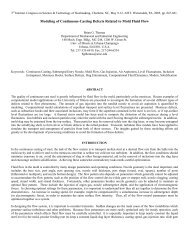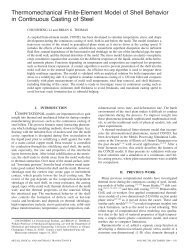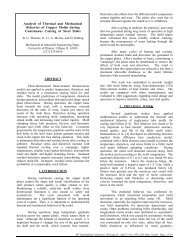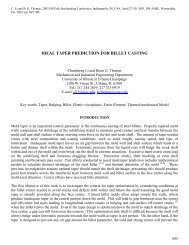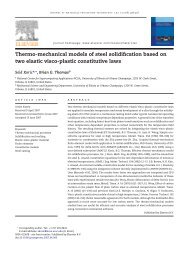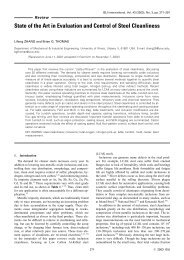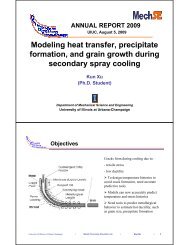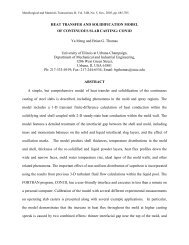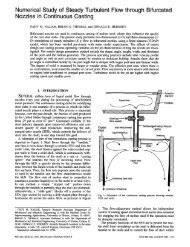1 Clogging in Continuous Casting Nozzles K. G. Rackers and B. G. ...
1 Clogging in Continuous Casting Nozzles K. G. Rackers and B. G. ...
1 Clogging in Continuous Casting Nozzles K. G. Rackers and B. G. ...
Create successful ePaper yourself
Turn your PDF publications into a flip-book with our unique Google optimized e-Paper software.
Internal step. A five millimeter annular step <strong>in</strong>corporated at the mid-height of the submerged<br />
entry nozzle has been found to decrease alum<strong>in</strong>a buildup <strong>in</strong> the lower part of the nozzle as well as<br />
decreas<strong>in</strong>g flow imp<strong>in</strong>gement on the mold wide face [55].<br />
Vary<strong>in</strong>g nozzle <strong>in</strong>ternal diameter. Increas<strong>in</strong>g th e nozzle <strong>in</strong>ternal diameter just below the stopper<br />
rod seat<strong>in</strong>g surface has reduced clogg<strong>in</strong>g [14, 56].<br />
Flat bottomed nozzle. Decreased port clogg<strong>in</strong>g was observed when the elevation of the nozzle<br />
<strong>in</strong>ternal bottom <strong>and</strong> port bottom were co<strong>in</strong>cident (i.e., no nozzle well) [55].<br />
Insulation around nozzle. Insulation, as well as preheat <strong>and</strong> heat<strong>in</strong>g, around the clogg<strong>in</strong>g location<br />
may reduce clogg<strong>in</strong>g [14].<br />
2, INITIAL MODELING EFFORTS<br />
The first steps we took to underst<strong>and</strong> nozzle clogg<strong>in</strong>g were to develop simple models of the<br />
various aspects of the clogg<strong>in</strong>g process. Described below are models which predict the strength of the<br />
clog buildup <strong>and</strong> the role of heat transfer <strong>in</strong> re<strong>in</strong>forc<strong>in</strong>g the clog buildup. In addition, the relationship<br />
between slide gate position <strong>and</strong> degree of clogg<strong>in</strong>g, the effect of clogg<strong>in</strong>g on air aspiration, the<br />
deposition rate of deoxidation products, <strong>and</strong> the role of reoxidation <strong>in</strong> clogg<strong>in</strong>g are discussed.<br />
2.1. Strength of the Clog<br />
The clog matrix has been described as a powdery friable buildup that could be easily removed by<br />
the touch of a f<strong>in</strong>ger [16]. To expla<strong>in</strong> the ability of this buildup to withst<strong>and</strong> erosion by the molten steel,<br />
Duderstadt [68] proposed that the clog was strengthened by solid steel dendrites which grew radially<br />
<strong>in</strong>ward due to heat loss through the nozzle wall. However, essentially pure alum<strong>in</strong>a buildups have been<br />
observed <strong>in</strong> practice [4, 10]. Furthermore, Ogibayashi et al. [10] claimed that the steel with<strong>in</strong> the clog<br />
matrix is liquid dur<strong>in</strong>g cast<strong>in</strong>g as evidenced by the observation of pure alum<strong>in</strong>a clogg<strong>in</strong>g <strong>and</strong> alum<strong>in</strong>a<br />
clogg<strong>in</strong>g with entrapped steel both appear<strong>in</strong>g <strong>in</strong> the same<br />
region. As mentioned above, Ogibayashi et al. concluded that the presence of pure alum<strong>in</strong>a or alum<strong>in</strong>a<br />
embedded <strong>in</strong> steel will be determ<strong>in</strong>ed by the steel cleanl<strong>in</strong>ess (i.e., concentration of alum<strong>in</strong>a <strong>in</strong> the steel).<br />
Two questions that are prompted by the above observations are:<br />
1) How dense must a clog matrix be to withst<strong>and</strong> erosion?<br />
2) How can steel cleanl<strong>in</strong>ess determ<strong>in</strong>e the clog morphology? In other words, if clog growth is<br />
envisioned as the entrapment of entra<strong>in</strong>ed deoxidation products by the clog matrix, then how does the<br />
rate at which the deoxidation products are entrapped (which will clearly be a function of concentration)<br />
affect where the deoxidation products are entrapped? In fact, s<strong>in</strong>ce the ejection of the steel from<br />
between the deposited deoxidation products [10] requires f<strong>in</strong>ite time, one might expect that the dirtier<br />
the steel the greater the amount of steel entrapped with<strong>in</strong> the clog.<br />
Simplified models to address these issues were developed <strong>and</strong> are discussed below:<br />
6



